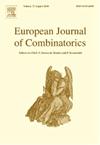A group action on cyclic compositions and γ-positivity
IF 0.9
3区 数学
Q1 MATHEMATICS
引用次数: 0
Abstract
Let be the number of Dyck paths of semilength with occurrences of and occurrences of . We establish in two ways a new interpretation of the numbers in terms of plane trees and internal nodes. The first way builds on a new characterization of plane trees that involves cyclic compositions. The second proof utilizes a known interpretation of in terms of plane trees and leaves, and a recent involution on plane trees constructed by Li, Lin, and Zhao. Moreover, a group action on the set of cyclic compositions (or equivalently, 2-dominant compositions) is introduced, which amounts to give a combinatorial proof of the -positivity of the Narayana polynomial, as well as the -positivity of the polynomial previously obtained by Bóna et al, with apparently new combinatorial interpretations of their -coefficients.
环组成与γ-正性的群作用
设wn,k,m为半长为n的Dyck路径的个数,其中UD出现k次,UUD出现m次。我们以两种方式建立了平面树和内部节点对数字wn,k,m的新解释。第一种方法建立在涉及循环成分的平面树的新特征上。第二个证明利用了已知的关于平面树和叶子的wn,k,m的解释,以及最近由Li, Lin和Zhao构造的平面树的对合。此外,在循环组合(或等价于2-优势组合)集合上引入了一个群作用,对Narayana多项式的γ-正性和先前Bóna等人得到的W2k+1,k,mtm的γ-正性进行了组合证明,并对它们的γ-系数进行了明显的组合解释。
本文章由计算机程序翻译,如有差异,请以英文原文为准。
求助全文
约1分钟内获得全文
求助全文
来源期刊
CiteScore
2.10
自引率
10.00%
发文量
124
审稿时长
4-8 weeks
期刊介绍:
The European Journal of Combinatorics is a high standard, international, bimonthly journal of pure mathematics, specializing in theories arising from combinatorial problems. The journal is primarily open to papers dealing with mathematical structures within combinatorics and/or establishing direct links between combinatorics and other branches of mathematics and the theories of computing. The journal includes full-length research papers on important topics.

 求助内容:
求助内容: 应助结果提醒方式:
应助结果提醒方式:


